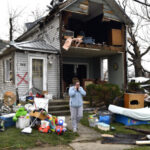EQECAT Inc., a provider in extreme risk modeling, said on Wednesday a review of hurricane trends showed there is more than a one in three chance of large hurricane catastrophe-losses in the United States in the current season, based upon current forecasts by the National Hurricane Center (NHC) which has suggested 2005 is likely to be an “above average” year.
“Although the current season might not be as severe and unusual as the 2004 season, the potential for large losses in 2005 is likely to be troubling to insurers and reinsurers, which will have to cover the potential hurricane damage claims,” said Tom Larsen, senior vice president of EQECAT.
The most recent forecasts by NHC have suggested 12 to 15 named storms are expected for 2005, with 7 to 9 becoming hurricanes, and 3 to 5 expected to be major hurricanes. The most recent 2005 NHC forecast also suggested the accumulated cyclone energy (ACE) index of storms in the current season will be between 120 percent and 190 percent of the median value.
“The forecast 2005 ACE index is similar to the ACE Index for 12 other years since 1950, among which 4 seasons resulted in very large losses,” Larsen said.
ACE is an index, which the National Oceanic and Atmospheric Administration (NOAA) uses, coupled with other information, to categorize North Atlantic hurricane seasons as being above normal, near normal, or below normal. NHC is a division of the National Weather Service’s Tropical Prediction Center.
“The 12 years with ACE values between 120% and 190% of the median included some seasons with severe and costly storms, such as Hazel, Carol, and Edna, all in 1954; Camille in 1969; Allen in 1980; and Hugo in 1989.
“A re-simulation of the 1954 season, which included Hurricanes Hazel, Carol and Edna, on today’s population could cause total losses exceeding $50 billion. Depending upon the areas impacted, a storm such as Camille could cause approximately $9 billion in insured losses; Allen approximately $4 billion; and Hugo approximately $8 billion,” said David Smith, director of EQECAT’s research group.
EQECAT said 2004 was excluded from this review of the hurricane seasons since 1950 because it, along with nine other years, had an ACE value even higher than the range forecast for 2005.
The four major hurricanes, which struck Florida and the nearby Gulf Coast area in the 2004 season, resulted in combined insured losses of more than $22 billion.
The number of storms anticipated for 2004 was 12 to 15 and the number of hurricanes predicted to be 6 to 8. The actual number of storms in 2004 was 15, with 9 of them hurricanes.
“The correlation of the NHC forecast to insured losses should motivate those with assets in hurricane-prone areas to re-examine their potential financial exposure in 2005,” Larsen said. “Fortunately, not all years expected to be ‘above average’ result in large insured losses. This is because financial losses are significantly impacted by storm landfall location and the population density in those areas.”
“EQECAT has been working closely with its clients since the end of the last season to help make sure they are fully prepared for the 2005 season,” he said. “While our models were largely accurate during the 2004 hurricane season and our clients were well-prepared for multiple, and serious events, some other insurers and reinsurers reportedly were caught off-guard.
“That is why recently we offered insurers a comparison test called the ‘2004 Hurricane Challenge’, in which we consistently demonstrated the ability of EQECAT models to generate better loss estimates for the 2004 storms than other models in use. We believe insurers and reinsurers should have the most reliable model estimates possible as the basis for their catastrophe management plans going into the 2005 season,” Larsen added.
Was this article valuable?
Here are more articles you may enjoy.

 MGM Resorts Sues US FTC to Stop Investigation of Casino Hack
MGM Resorts Sues US FTC to Stop Investigation of Casino Hack  Gallagher: Global Insured Natural Disaster Claims Again Dominated by Severe U.S. Storms
Gallagher: Global Insured Natural Disaster Claims Again Dominated by Severe U.S. Storms  California Chiropractor Sentenced to 54 Years for $150M Workers’ Comp Scheme
California Chiropractor Sentenced to 54 Years for $150M Workers’ Comp Scheme  CoreLogic Report Probes Evolving Severe Convective Storm Risk Landscape
CoreLogic Report Probes Evolving Severe Convective Storm Risk Landscape 